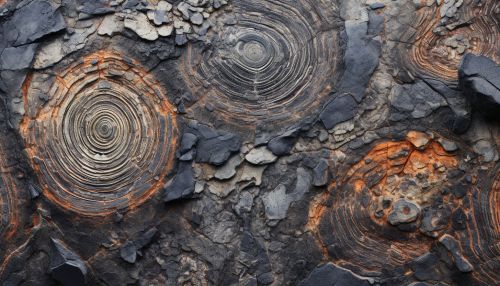Trace Fossils and Paleoenvironmental Reconstruction
Introduction
Trace fossils, also known as ichnofossils, are geological records of biological activity. They are not the remains of the organism itself, but rather the impressions, tracks, burrows, borings, or feces left behind by an organism. Trace fossils can provide valuable insights into the behavior and environment of ancient life forms, and are therefore crucial in paleoenvironmental reconstruction.


Types of Trace Fossils
There are several types of trace fossils, each providing unique information about the organism that created it and the environment in which it lived.
Tracks and Trails
Tracks and trails are the footprints or paths left by an organism as it moved across a surface. These can provide information about the size, gait, and speed of the organism, as well as the substrate on which it was moving.
Burrows and Borings
Burrows and borings are holes or tunnels dug into a substrate by an organism. These can provide information about the size and shape of the organism, as well as its behavior and the nature of the substrate.
Coprolites
Coprolites are fossilized feces. They can provide information about the diet and digestive system of the organism, as well as the environment in which it lived.
Paleoenvironmental Reconstruction
Paleoenvironmental reconstruction is the process of using fossils and other geological evidence to reconstruct the environment of the past. This can provide valuable insights into the climate, geography, and ecology of ancient times.
Climate Reconstruction
Trace fossils can provide clues about the climate of the past. For example, the presence of certain types of trace fossils can indicate a wet or dry climate, or a warm or cold climate.
Geographic Reconstruction
Trace fossils can also provide clues about the geography of the past. For example, the presence of marine trace fossils can indicate that an area was once underwater, while the presence of terrestrial trace fossils can indicate that an area was once land.
Ecological Reconstruction
Trace fossils can provide insights into the ecology of the past. For example, the presence of certain types of trace fossils can indicate the presence of certain types of plants or animals, or the nature of the interactions between different species.
Importance of Trace Fossils in Paleoenvironmental Reconstruction
Trace fossils play a crucial role in paleoenvironmental reconstruction. They can provide a wealth of information about the behavior and environment of ancient organisms, which can in turn provide insights into the climate, geography, and ecology of the past.
Behavioral Information
Trace fossils can provide information about the behavior of ancient organisms. For example, they can provide insights into the feeding habits, locomotion, and reproductive behavior of ancient organisms.
Environmental Information
Trace fossils can provide information about the environment in which ancient organisms lived. For example, they can provide insights into the substrate, water depth, temperature, and salinity of the ancient environment.
Conclusion
Trace fossils are a valuable tool in paleoenvironmental reconstruction. They provide a wealth of information about the behavior and environment of ancient organisms, and can therefore provide valuable insights into the climate, geography, and ecology of the past.
